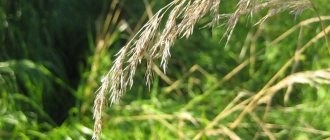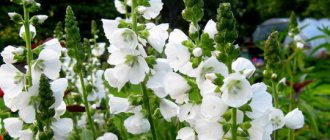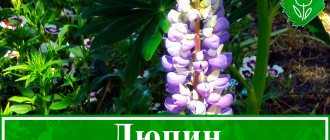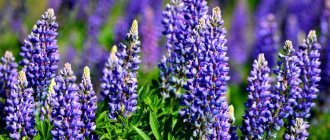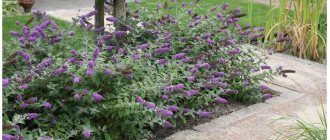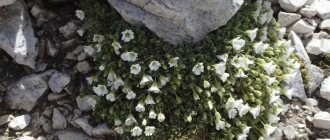Arabis bushes, blooming in early spring in white or pink, are an exceptionally beautiful decoration for a garden or rockery. This perennial is often used to create rock gardens; it is one of the most important types of ground cover plants. The bushes grow quickly, forming dense cascades or flower carpets. In this article we will tell you how to grow perennial Arabis - planting and care in open ground, and present photos of the species and varieties of this popular plant.
2.Description - what it looks like
Arabis or rezuha is a compact herbaceous perennial plant - a relative of the well-known cabbage and radish. In appearance, the flower is a little reminiscent of these plants.
Bushes with a small, fibrous root system and a basal rosette of leaves.
The leaf blades are oblong - lanceolate, entire or with small teeth, on short petioles. In many varieties the surface of the leaves has rich light pubescence, in others the leaves are glossy and green.
During the flowering period, plants form tall shoots with small, sessile, alternately arranged leaves. The higher such a leaf is located, the smaller its size. If the stems bend to the surface of the ground, they easily form roots upon contact with it.
At the tops of the shoots there are branched peduncles with small inflorescences - umbrellas. The flowers are white, pink or lilac, with 4 rounded petals and a honey aroma.
There are varieties with double flowers up to 1.5 cm in diameter. After flowering, oblong pods with fairly large, brown, flat seeds appear on the bushes.
↑ Up,
Height . The plants reach a height of 20–30 cm.
Fertilizers for plants
Arabis does not need frequent feeding, and it is enough to apply fertilizer to the plant twice a year.
Mineral mixtures
Mineral preparations are added to the soil only before the plant blooms, which occurs at the end of April. Arabis is suitable for universal preparations intended for flowering crops , for example, Kemira Lux, Agricola or Pokon. It is necessary to apply these preparations only after watering, choosing a cloudy day.
Organic fertilizers
It is better to feed Arabis with organic fertilizers in the fall, before preparing for wintering. And for this you should use only humus.
It needs to be spread under the bush in a layer of 1-2 cm. Such a layer will not only feed the crop, but will also protect it from pests and increase frost resistance.
4.Planting and care in open ground
To grow Arabis, select a site that is brightly lit by the sun; when grown in the shade, the plants bloom reluctantly. Areas with fairly strong winds are suitable for the flower - the flower is not afraid of even fairly strong gusts.
Before sending a flower to its permanent place of residence - in the garden, it is worth hardening off the seedlings. To do this, cups with young plants are taken out into the fresh air for several hours a day for 10 - 12 days, gradually increasing the exposure time. When hardening, you should ensure that the seedlings are not exposed to cold drafts.
↑ Up,
4.1.How and when to plant a flower
Planting seedlings is usually postponed until the second half of May - at this time there should be no return night frosts.
The area is dug up and cleared of weeds. Prepare planting holes whose depth and width exceed the volume of the root ball of the seedlings. The distance between the holes is about 40 cm. - It is worth remembering that this flowering perennial grows quite quickly and easily captures more and more new territories.
Arabis bushes 6–8 cm high with 3 or more true leaves are suitable for planting in the garden. In order to get denser plants, bushes are planted in 2 - 3 pieces. in one hole. Plants are sprinkled with substrate.
↑ Up,
After planting, the soil around the flowers is lightly compacted and watered generously with plenty of water. During the first 2 - 3 weeks, make sure that the soil remains evenly moist, but not waterlogged.
In the first year of planting, like most plants of the family, only a leaf rosette appears. Peduncles and buds are formed only in plants of the second and subsequent years of life.
↑ Up,
4.2.Soil
To grow Arabis, select soil that is easily permeable to water and air without a large amount of melt water; flooded lowlands are also not suitable for planting.
In soils that are too dense and contain a lot of clay, add river sand or small pebbles to improve drainage. Rezuha prefers neutral or slightly alkaline substrates; arabis does not like soils with a high calcium content - it slows down its development and blooms less profusely.
↑ Up,
4.3.How to care for Arabis in the garden
Rezuha is quite unpretentious, however, it will require a little care from time to time.
The flower is watered periodically, and it is worth remembering that adult plants can tolerate drought quite easily, but can rot from abundant and frequent watering. Watering is carried out in the morning or evening, trying to avoid drops of water falling on the leaf blades during the day.
After watering, the soil is loosened and weeds are removed. Mature Arabis bushes will form such dense grassy mats that, completely shading the surface of the soil, they themselves will fight weeds.
↑ Up,
To ensure abundant and long-lasting flowering, the bushes are fed.
To maintain an attractive appearance and prevent the spread of various diseases, old and dried leaves are removed in a timely manner.
Peduncles with fading buds are cut off at the base with sharp sterile pruners, preventing the formation of seeds and self-seeding. Additionally, plants that have not spent their energy producing pods and seeds may rebloom in the fall months.
Creeping stems are shortened so that they do not spread the flower over a large area.
↑ Up,
4.4.Feeding
To enrich the soil with nutrients, well-rotted turf and leaf humus, cow or horse manure are mixed into the soil.
Plants respond well to the use of mineral fertilizers with a high content of potassium and phosphorus - such compositions help to form a large number of buds.
When grown in open ground, 2 - 3 feedings per season will be sufficient.
↑ Up,
4.5.How and when to replant a perennial
The rhizome is replanted after complete flowering, for example in August. Plants aged 4 or more years are divided when transplanted, since with age large bald patches appear in the center of adult bushes. It is best to use transshipment - move the bushes to a new place along with the root ball without destroying it. This method of transplantation helps plants quickly adapt to a new location.
During the first time after transshipment, the flower is watered in a timely manner and shaded from direct sun for 5 - 6 days.
↑ Up,
4.6.Wintering in open ground
In the absence of snow cover, Arabis easily freezes, as it can only tolerate light frosts - not lower than - 7 degrees Celsius. In order to help the flower successfully survive until spring, it should be prepared for the onset of cold weather in mid-autumn, before the first night frosts.
The plants are trimmed, leaving only 3 - 4 cm of growth, and the root system is mounded high, sprinkled with soil. The bushes are covered on top with dry leaf litter, pine or spruce spruce branches or agricultural material.
In the first days of spring, when the sun begins to warm up and the temperature at night does not drop below 3 - 5 degrees below zero, the shelter can be completely removed.
↑ Up,
Choosing a place in the garden, soil requirements
Alpine and Caucasian Arabis are great for growing in the garden; they do not need to get a lot of sun or heat. However, the optimal position for growing Arabis should be full sun, with the exception of the Plena variety, which grows best in partial shade. The plant tolerates low temperatures well, but it is evergreen, so strong frosty gusts of wind can damage it. The particularly delicate Rosalita variety and some other more delicate varieties may not cope well in areas where there are frequent drafts in winter.
Optimal soil for Arabis:
- limestone;
- infertile;
- moderately humid;
- the shrub is very resistant to the pH of the substrate - it prefers alkaline soil, but will cope with slightly acidic soil; soil with a neutral or slightly alkaline reaction (pH 6-8) is also suitable;
- permeable – it is worth mixing the soil with expanded clay or other material that will be used as drainage, preventing water retention.
Arabis grows poorly on soils:
- heavy;
- cold;
- too wet;
- dry sandy.
Arabis does not like soils where water stagnates for a long time. Excess water increases the risk of fungal diseases and plant death.
5.Reproduction
There are many ways to propagate Arabis and all of them are not particularly difficult. The choice of a specific method will depend on the species and varietal characteristics of the flower.
Species plants can be safely propagated by seeds - the daughter bushes thus obtained will exactly match the appearance of the parents.
Varietal plants, when propagated by seed, lose their attractiveness and declared characteristics - they are propagated by any vegetative means - division, air layering, stem and leaf cuttings.
Terry varieties do not form seeds at all after flowering.
↑ Up,
5.1.Growing from seeds
Sowing seeds is carried out both directly in open ground, before winter, and at home in early April - for seedlings.
When sowing in winter, it is worth choosing the timing so that the first shoots do not have time to appear before the onset of frost. Shoots usually appear together.
↑ Up,
5.1.1.Seed collection
In order to obtain planting material with good germination, it is necessary to allow the pods to fully ripen on the plants. The largest and most brightly colored flowers are selected for collection.
To prevent the pods from spontaneously opening and throwing the seeds to the ground, they are wrapped in gauze or a bandage in advance. They try to carry out the collection on fine, warm days.
The collected seeds are dried for several hours in a warm and well-ventilated place, spread out on sheets of paper. After drying, the seeds are placed in paper bags, stored and used as needed for 1 - 2 years.
↑ Up,
5.1.2.Sowing seeds
When sowing seedlings for growing Arabis, take special seedling boxes with transparent lids and make drainage holes on them. The first layer is drainage, and then the rest of the volume is filled with nutritious and loose soil, 1/3 consisting of river sand.
The seeds are sown evenly over the surface of the substrate and covered on top with a layer of earth about 5 mm thick.
The boxes are covered with lids or covered with non-woven material and placed in a fairly cool place with a temperature of about 18 degrees. The location should be brightly lit but out of direct sunlight.
↑ Up,
The shelter is removed daily for ventilation, gradually increasing the time. With the appearance of the first shoots, the shelter is completely removed.
The soil in the boxes is kept evenly moist, but not waterlogged, by spraying water from a spray bottle.
With the appearance of the first 1 - 2 true leaves, the plants are planted in individual cups or pots. Diving is carried out as carefully as possible, trying not to pick up the bushes along with a lump of earth and not to injure the long roots.
7 - 10 days after diving, the plants can be fed for the first time with nitrogen fertilizers in a very low concentration.
↑ Up,
5.2.Propagation by cuttings
Since many terry varieties do not form seeds, and in order to fully preserve the varietal characteristics of plants, vegetative propagation methods are used, including cuttings.
Arabis is cut from leaf or stem cuttings.
↑ Up,
5.2.1.Leaf cuttings
Leaf cuttings cannot be separated with scissors, but should definitely be torn off with your hands, slightly pulling the leaf down. With this method of separation, a small heel remains at the base of the petiole - the cambial layer on the outside of the shoot.
For rooting, use small flower pots filled with nutritious soil mixture. The leaf petiole is immersed in the soil just a few millimeters and the substrate is kept evenly moist.
After some time, young growth will be visible at the base of the leaf.
↑ Up,
5.2.2.Stem cuttings
Another method of cuttings is the use of stem cuttings - such cuttings are cut after flowering so that their length is 8 - 10 cm.
The lower leaves are removed to reduce moisture loss and the base is dusted with growth hormones. Immerse the cuttings in a moist substrate approximately 1 cm deep at a slight angle.
The tops of the pots are covered with a transparent plastic bag or glass to create a greenhouse effect and maintain high air humidity.
↑ Up,
Place the pots with cuttings in a well-lit place without direct sun access; the air temperature in such a room should be in the range from 18 to 22 degrees.
The cover is removed daily, ventilating the young bushes and wiping off any water condensation that appears. With the appearance of the first roots, the leaves become strong and elastic again, and new, young shoots appear at the base of the cutting.
↑ Up,
5.3. Reproduction by air layering
One of the simplest methods of propagation, which is carried out in late spring or early summer. The side shoots of Arabis are inclined to the surface of the earth, pinned and dug a little into the ground.
The top of the shoot should remain above the ground and should be pinched a little. The soil surface is always kept moist.
If you follow this agricultural technology, in a couple of weeks the first young leaves will appear from the buried part.
On each layer, several root systems can appear at once - according to the number of buried leaf nodes. When such a layer gets stronger, it is completely separated from the mother bush, divided into sections with separate roots and planted.
↑ Up,
5.4.Dividing adult plants
If necessary, in case of transplantation, you can divide the overgrown Arabis bushes into several parts.
Division is carried out after complete flowering - in the second half of summer. The bushes are dug out of the ground and the roots are shaken off from remaining soil.
The plants are cut into several sections with a sharp knife, making sure that well-developed roots and leaves remain in each piece.
The wound surface is sprinkled with crushed charcoal and the cuttings are planted in the desired location.
↑ Up,
5.5.Diseases and pests
Bushes that receive proper care rarely suffer from diseases; most often, fungi and viruses appear on weakened plants.
When a viral mosaic appears, the leaf blades acquire an uncharacteristic shade - plants affected by the virus cannot be treated. The bushes are dug up and destroyed; such specimens cannot be sent to the compost bin either. The area where the infected plant was found is watered with boiling water, in which quite a lot of potassium permanganate has been dissolved.
Sometimes downy mildew and rust appear.
Like most related plants, Arabis is susceptible to cruciferous flea beetle infestations. Of the small rodents, shrews can annoy plants.
↑ Up,
Landing - timing, landing scheme
Growing Arabis begins with planting bushes.
Many gardeners ask when is the best time to plant Arabis. The best date for planting is the autumn months (September, October, depending on the region). Arabis seedlings in most regions are recommended to be planted before mid-September.
During the first two weeks after planting, a moderately warm temperature (about 20 degrees C) is required. Thanks to autumn planting, the bushes will have time to take root in a permanent place and will be less susceptible to frost.
Arabis seedlings
You can sow seeds for seedlings, but germination and development of seedlings requires about 20 degrees Celsius. Growing Arabis seedlings is described below, here.
It is worth choosing the planting site for Arabis carefully, as the species does not tolerate transplantation well.
This ground cover plant grows rapidly, so it is necessary to maintain the proper distance between seedlings - 25 cm between adjacent bushes. 9-10 seedlings are planted per 1 m².
6. Application in landscape design
Its compact size and abundant and long-lasting flowering have made Arabis very popular among modern gardeners. Bushes are often used as edging for paths and flower beds, planting them in the foreground.
Thanks to the early flowering, the rezuha becomes one of the main decorations of the spring alpine hill.
As a ground cover plant at the foot of large trees, you can use variegated rhizome - bushes with bright leaves will look attractive without abundant flowering, which will not occur in the shade.
↑ Up,
Even after complete flowering, the low, rounded bushes serve as one of the main attractions of the garden.
With a large number of buds that have a sweetish aroma, Arabis serves as an excellent honey plant and attracts many beneficial insects to the site.
Thanks to its miniature dimensions, the flower can serve as a decoration for a loggia and balcony.
↑ Up,
Germination of seeds
It is very easy to grow rhizomes by simply sowing the seeds directly into the ground before winter . Of course, not all seeds will germinate with this planting method.
How to sow seeds
To increase the number of seedlings, it is better to take care of growing seedlings . The optimal time for planting is April. You can sow in mini-greenhouses or regular boxes.
The soil for planting should be loose, moderately nutritious, with good drainage qualities . The seeds are not planted deep into the soil; half a centimeter is enough.
It is recommended to cover the container with the crops with cling film - this will allow for friendly shoots.
Seedling
The seedlings do not require special . Place the container in a warm, well-lit place. Open daily for ventilation and water with a spray bottle.
After germination, the film can be completely removed.
Arabis pick
When real leaves appear on the seedlings, they need to be picked into a separate container . Then the plants will grow in it until they are planted in the ground.
7. Varieties and types of Arabis:
7.1. Alpine Arabis - Arabis alpina
Plants are native to southwestern Europe and the Mediterranean. This flowering perennial reaches a height of 20 cm, bushes grow up to 1 m in diameter. The leaves grow all year round, flowering occurs in April - May, and the seeds ripen in June - July.
↑ Up,
7.2. Caucasian Arabis - Arabis caucasica
This species is often considered a subspecies of Arabis alpine. In nature, plants are found in the Caucasus, Turkey, and Crimea. A perennial herbaceous plant up to 30 cm high with fine-toothed, oblong-oval leaves. The flowers are quite large, reaching 1.5 cm in diameter.
↑ Up,
Rules for pruning plants
Perennial Arabis tolerates pruning well, and if it is not done, the bush will quickly grow and “strangle” neighboring crops. To prevent this, you need to remove excess layers once a month. They can be used for crop propagation.
To prevent perennial arabis from growing, drowning out neighboring plants, it should be pruned
To make Arabis look well-groomed and decorative, you will also need to remove faded inflorescences. And in order to get the plant to bloom again, you can shorten the long young shoots in June and completely remove the old ones. Then, by autumn, new buds form on the bush.
Gardeners' opinion
The following are reviews from those who grow Arabis in open ground in the middle latitudes of Russia and the CIS:
I bought the seeds by accident, knowing nothing about this plant. Planted along the path. It turned out that virtually no maintenance is required. Blooms in May and early June. Winters under the snow. After flowering, boxes with seeds remain, which spoil the appearance a little - I remove them. In the spring, when it gets warmer, it immediately begins to grow.
Tatiana
Two years ago I bought packets of pink and white Arabis seeds. Not all seeds sprouted. The first year there were no flowers. But the next day there was a magnificent flowering.
Lydia
This plant requires almost no care. It pleases with luxurious flowering and tolerates winter with virtually no additional measures. In order for it not to lose its appearance, it must be trimmed, giving it the desired shape.
After flowering
At the end of the flowering period of Arabis perennial, you need to properly collect the seeds, and then prepare the plant for wintering.
Collection and storage of seeds
Even during the flowering of Arabis, you should look for the most beautiful, strong and healthy inflorescences. They are suitable for subsequent seed collection. This should be done after the first frost on a dry and sunny day. It is not recommended to collect in rainy weather, as this will negatively affect the germination of seeds.
The inflorescences should be cut off along with part of the shoot.
In a well-ventilated area, they should be dried naturally in a suspended state. After this, you need to remove the seeds, place them in a small cardboard box and store them in a dark place, protected from moisture.
Preparing for winter
Being a cold-resistant plant, Arabis can withstand temperatures of -5-7 °C without special shelter. However, with a more significant drop in temperature, it will need reliable protection.
See also
Varieties of petunias Easy Wave with description, planting and careRead
When severe frosts occur, you need to trim the stems so that approximately 20-40 mm sections remain on the surface. After this, you should make a shelter for this area - it can be made of spruce branches, a special covering material or a layer of dry leaves.
